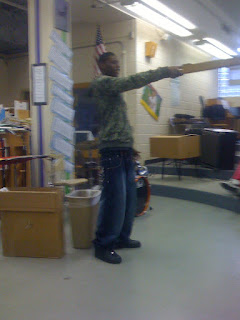The flowers and sounds are in place, lovely dancing from Jan Louise's team, and young and old are enjoying the plant orchestra. Here's the video of the setting up process. The tear-down will follow all too soon.
Friday, May 29, 2009
Wednesday, May 27, 2009
In the midst of setting up
 It shouldn't be 50º and raining today but it is and the flowers don't mind, only the hordes of volunteers putting this all together. So far so good: Plants looks great, speakers in place and beginning to look like toadstools. They sound fine but much more subtle than indoors away from bus engine noises. Tomorrow is perfecting the spinnies and firing up the talking plant.
It shouldn't be 50º and raining today but it is and the flowers don't mind, only the hordes of volunteers putting this all together. So far so good: Plants looks great, speakers in place and beginning to look like toadstools. They sound fine but much more subtle than indoors away from bus engine noises. Tomorrow is perfecting the spinnies and firing up the talking plant.Lovely story in the Pioneer Press above and below the fold.
Here's the invite to my friends:
Stroll through the Singing Garden and converse with a Talking Plant
Please visit Philip Blackburn’s sound installation this weekend. You will hear a 20-channel soundscape created from dozens of vegetable sounds (from coconut milk to Rice Krispies to acorn squash clarinets); a kind of vegan frogpond at dusk. Don’t miss the spinning flower beds that strike bamboo chimes in a spatial phasing pattern (a safe alternative to LSD). You will notice this all takes place in a colorful 50-foot diameter flower carpet pieced together by the St. Paul Parks Department. Pretty.
 Then there’s the Talking Plant. This is a Bird of Paradise plant that has been wired up with a brainwave sensor that spits out MIDI signals from its stalk. J. Anthony Allen wrote the MaxMSP patch to convert those data to trigger yet more vegetable samples (from cactus needles to rubber bands). Amaze your friends by playing the plant like an organic Theremin; it’s an intelligent salad.
Then there’s the Talking Plant. This is a Bird of Paradise plant that has been wired up with a brainwave sensor that spits out MIDI signals from its stalk. J. Anthony Allen wrote the MaxMSP patch to convert those data to trigger yet more vegetable samples (from cactus needles to rubber bands). Amaze your friends by playing the plant like an organic Theremin; it’s an intelligent salad.This is all part of the Flint Hills International Childrens Festival at the Ordway and throughout Rice Park so bring the family and you’ll find plenty of other stuff to do. All free.
 More on the Singing Garden and the Talking Plant:
More on the Singing Garden and the Talking Plant:http://oddsandendsorchestra.blogspot.com/
When:
Friday, May 29-Sunday, May 31
9 am — 4pm
Where:
Landmark Plaza, next to Landmark Center (where the skating rink usually is), Rice Park, downtown St. Paul (take the 5th Street or Kellogg exit from 94)


Thursday, May 21, 2009
The Talking Plant Talks
 Ever wondered what plants think when you play with them? Some say that saying nice things will help them grow and that playing heavy metal causes them to wilt. They did evolve pretty well to find light and nutrients and whatever life force is going up and down their stalks might contain their deepest wisdom...
Ever wondered what plants think when you play with them? Some say that saying nice things will help them grow and that playing heavy metal causes them to wilt. They did evolve pretty well to find light and nutrients and whatever life force is going up and down their stalks might contain their deepest wisdom...Anyway, here's what this Bird of Paradise had to say when I conversed with it this evening. I bet the kids have fun with this next week: it's quite sciencey and amusing in a metaphysical sort of way.
Last day of class, listening to the Singing Garden
This summary is not available. Please
click here to view the post.
Friday, May 15, 2009
Spinners and Zombies






Today we figured out the engineering solutions for the rotating plant frames and how to get the biggest Oomph to strike the instruments underneath. A golf ball is suspended with string from the frame of the plantbed, sometimes it goes up a ramp, and then it falls back down onto a bamboo chime or wooden clapper that is placed at just the right spot and is free to vibrate. It takes time to tune perfectly. When all 5 spinners are going, each with one tone block, the space and the phasing will add dramatically to the effect.
Then we hooked up the brainwave, proximity, and turn sensors to ourselves (a plant was not available at school). Philip's brain activity is steady 60-62 range, students got a 0-127 sweep much more easily. One of us may be a zombie. We could definitely hear the effects of our activities and motion even though the sounds were many and complex.
Monday, May 11, 2009
Sensing Plants and Sounds from Salad
 What does a plant think when you go near it?
What does a plant think when you go near it?Why not put a brainwave sensor on it and ask?
Thanks to the ingenious programming of Jay Anthony Allen, moral support of Brian Heller, and sample crunching of Preston Wright we can now find out. I have three electrical sensors: a Biowave (brainwave EKG set of electrodes), proximity and turn knobs. These send MIDI data to my laptop that can be mangled and interpreted by a custom MaxMSP patch. The output triggers a few hundred samples derived from our vegetable recordings, hopefully in interesting ways.




Tests so far are promising and whether the human gardener or plant itself are wearing the sensor there is a reaction when the plan is touched. I am tweaking the dials and optimizing the samples so that effect is amplified. I will also try different plants to get better electrical conductivity from their stems and leaves; the small philodendron is fine but maybe a huge Bird of Paradise would be more dramatic. I imagine the xylem flowing up the tubes has some electrical capacity...
Here are some more pics of sound sources we have recorded:
Watermelon drums (tap on the outside and record with a contact mic), or bring the two halves together for that clip-clop effect;
Two boxes of whole grain spaghetti make for a full throated rattle;
Onion skin = super crinkly
Sunday, May 10, 2009
Patrick Henry in the Studio and Listening to Soundscapes
The Patrick Henry Vegetable band has been busy listening, playing and being weirded out by veggie sounds. Over the last couple of meetings we have:
Recorded solos, duets and group performances on:
• rubber floor tiles
• cantaloupe melon drum
• cabbage
• leeks (these greens were unfamiliar to many)
• bok choy
• popcorn rattle
• a rubber band whizzer device and
• a collection of wooden organ pipes.

We listened to a variety of ecosystem sounds (on Wildsanctuary.org):
• Loons on Echo Pond
• Costa Rican Rainforest
• Amazon Jungle
and graphed the sonogram of the sounds and the acoustic niche that each animal inhabits.
We looked at landscape paintings for detail and global images:
Brueghel
Constable
Chinese Scroll painting
We learned about top-down organization (hierarchical) of groups (by having a leader determine when someone should play a sound), and bottom-up (dynamic, when everyone can play whenever they want so long as they listen carefully and communicate).
We listened to a series of recordings that group social-musical interactions into three groups:
ME
ME + YOU
US
ME
whistling in the street
dog barking
Humpback whale
Bobby McFerrin: Blackbird
ME + YOU
Whale + Nightingale (!) duet
Thavil Indian Drum duet
Tallis: 40 Part Motet: Spem in Alium
US
Samoan cicadas and slit log drums
Freshwater pond insects
Arcade sounds
We took the birdsong challenge at Wildmusic.org to identify the thrush songs. Amazing to hear the detail when slowed down, and to watch the sonogram. They are not just chirping up in those spring trees.













Recorded solos, duets and group performances on:
• rubber floor tiles
• cantaloupe melon drum
• cabbage
• leeks (these greens were unfamiliar to many)
• bok choy
• popcorn rattle
• a rubber band whizzer device and
• a collection of wooden organ pipes.

We listened to a variety of ecosystem sounds (on Wildsanctuary.org):
• Loons on Echo Pond
• Costa Rican Rainforest
• Amazon Jungle
and graphed the sonogram of the sounds and the acoustic niche that each animal inhabits.
We looked at landscape paintings for detail and global images:
Brueghel
Constable
Chinese Scroll painting
We learned about top-down organization (hierarchical) of groups (by having a leader determine when someone should play a sound), and bottom-up (dynamic, when everyone can play whenever they want so long as they listen carefully and communicate).
We listened to a series of recordings that group social-musical interactions into three groups:
ME
ME + YOU
US
ME
whistling in the street
dog barking
Humpback whale
Bobby McFerrin: Blackbird
ME + YOU
Whale + Nightingale (!) duet
Thavil Indian Drum duet
Tallis: 40 Part Motet: Spem in Alium
US
Samoan cicadas and slit log drums
Freshwater pond insects
Arcade sounds
We took the birdsong challenge at Wildmusic.org to identify the thrush songs. Amazing to hear the detail when slowed down, and to watch the sonogram. They are not just chirping up in those spring trees.













Subscribe to:
Comments (Atom)
